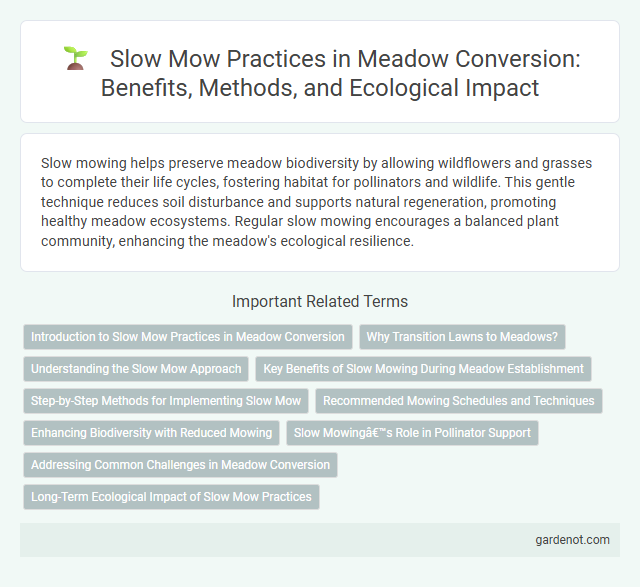Slow mowing helps preserve meadow biodiversity by allowing wildflowers and grasses to complete their life cycles, fostering habitat for pollinators and wildlife. This gentle technique reduces soil disturbance and supports natural regeneration, promoting healthy meadow ecosystems. Regular slow mowing encourages a balanced plant community, enhancing the meadow's ecological resilience.
Introduction to Slow Mow Practices in Meadow Conversion
Slow mow practices in meadow conversion promote biodiversity by allowing native plants and wildflowers to complete their life cycles, supporting pollinators and wildlife habitats. Implementing slow mow involves reducing mowing frequency and timing cuts to avoid peak flowering and seed-setting periods, which enhances ecosystem resilience. This approach minimizes disturbance, encourages soil health, and contributes to the gradual transformation of managed landscapes into thriving meadows.
Why Transition Lawns to Meadows?
Transitioning lawns to meadows promotes biodiversity by providing habitats for pollinators like bees, butterflies, and birds, supporting ecosystem health. Meadows require less water, fertilizer, and mowing frequency, leading to reduced environmental impact and lower maintenance costs. Slow mowing allows native plants to complete their life cycles, enhancing soil quality and long-term sustainability of green spaces.
Understanding the Slow Mow Approach
The Slow Mow approach to meadow conversion emphasizes reducing mowing frequency to promote biodiversity and enhance native flora growth. This method allows wildflowers and grasses to complete their life cycles, increasing habitat availability for pollinators and other wildlife. Adopting Slow Mow techniques supports ecological balance and fosters resilient, natural landscapes.
Key Benefits of Slow Mowing During Meadow Establishment
Slow mowing during meadow establishment supports native plant growth by reducing disturbance to young shoots and preserving early wildflower blooms, which enhances biodiversity and habitat quality. It encourages deeper root development and improves soil health by maintaining organic matter and promoting microbial activity. Slow mowing also minimizes soil compaction and reduces nutrient runoff, contributing to a sustainable and resilient meadow ecosystem.
Step-by-Step Methods for Implementing Slow Mow
Slow mow techniques for meadow conversion involve gradually reducing mowing frequency to promote native grasses and wildflowers. Begin by identifying areas for phased mowing, cutting only sections on a rotating schedule to allow plants to seed and establish. Monitor growth patterns and adjust intervals, aiming for mowing once or twice per season to maintain biodiversity and ecosystem health.
Recommended Mowing Schedules and Techniques
Slow mow techniques enhance meadow biodiversity by allowing wildflowers and grasses to reach full maturity, promoting seed dispersal and habitat for pollinators. Recommended mowing schedules suggest cutting once or twice per year, preferably late summer to early autumn, to maintain plant health and encourage diverse species growth. Employing a high cutting height and removing cuttings prevents nutrient build-up, preserving the low-fertility conditions essential for meadow ecosystems.
Enhancing Biodiversity with Reduced Mowing
Slow mow practices in meadow conversion significantly enhance biodiversity by allowing native plants to flower and set seed, supporting diverse pollinators and wildlife habitats. Reduced mowing frequency increases structural diversity in vegetation, creating microhabitats essential for insects, birds, and small mammals. This approach promotes ecological balance and resilience by fostering a rich variety of plant species and associated fauna.
Slow Mowing’s Role in Pollinator Support
Slow mowing enhances biodiversity by allowing wildflowers and native grasses to bloom fully, providing essential nectar and pollen for pollinators like bees and butterflies. This practice supports the life cycles of various pollinating insects, increasing their population and promoting healthy ecosystems. Establishing slow-mowed meadows creates valuable habitats, contributing to overall pollinator conservation and ecosystem resilience.
Addressing Common Challenges in Meadow Conversion
Slow mowing techniques promote biodiversity by allowing wildflowers to complete their life cycles, enhancing habitat for pollinators and wildlife. Addressing common challenges in meadow conversion includes controlling invasive species and managing soil nutrient levels to prevent dominance of aggressive grasses. Regular monitoring and adaptive mowing schedules are essential to sustain meadow health and ecological balance.
Long-Term Ecological Impact of Slow Mow Practices
Slow mow practices in meadow conversion enhance biodiversity by allowing flowering plants to complete their life cycles, supporting pollinators and other wildlife habitats. This method improves soil health through increased organic matter and promotes carbon sequestration, contributing to climate resilience. Over time, slow mowing establishes a stable, diverse ecosystem that requires less intervention and sustains ecological balance.
Slow mow Infographic

 gardenot.com
gardenot.com